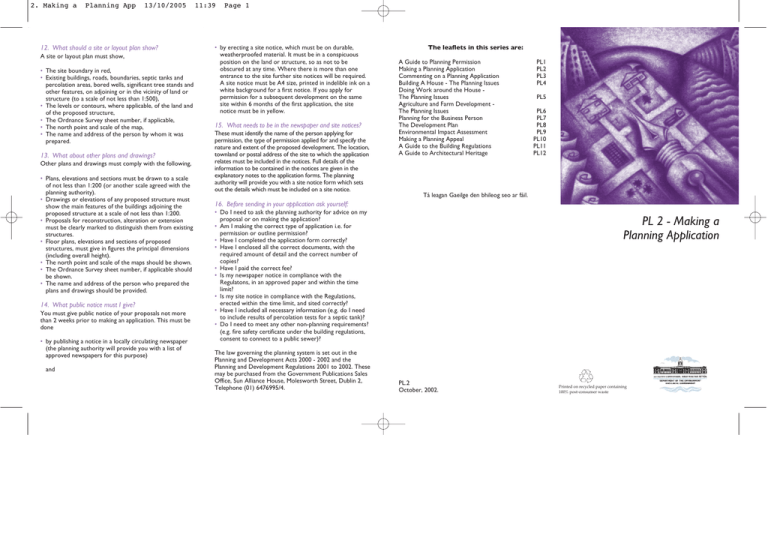Making a Planning Application
advertisement

2. Making a Planning App 13/10/2005 12. What should a site or layout plan show? A site or layout plan must show, • The site boundary in red, • Existing buildings, roads, boundaries, septic tanks and percolation areas, bored wells, significant tree stands and other features, on adjoining or in the vicinity of land or structure (to a scale of not less than 1:500), • The levels or contours, where applicable, of the land and of the proposed structure, • The Ordnance Survey sheet number, if applicable, • The north point and scale of the map, • The name and address of the person by whom it was prepared. 13. What about other plans and drawings? Other plans and drawings must comply with the following, • Plans, elevations and sections must be drawn to a scale of not less than 1:200 (or another scale agreed with the planning authority). • Drawings or elevations of any proposed structure must show the main features of the buildings adjoining the proposed structure at a scale of not less than 1:200. • Proposals for reconstruction, alteration or extension must be clearly marked to distinguish them from existing structures. • Floor plans, elevations and sections of proposed structures, must give in figures the principal dimensions (including overall height). • The north point and scale of the maps should be shown. • The Ordnance Survey sheet number, if applicable should be shown. • The name and address of the person who prepared the plans and drawings should be provided. 14. What public notice must I give? You must give public notice of your proposals not more than 2 weeks prior to making an application. This must be done • by publishing a notice in a locally circulating newspaper (the planning authority will provide you with a list of approved newspapers for this purpose) and 11:39 Page 1 • by erecting a site notice, which must be on durable, weatherproofed material. It must be in a conspicuous position on the land or structure, so as not to be obscured at any time. Where there is more than one entrance to the site further site notices will be required. A site notice must be A4 size, printed in indelible ink on a white background for a first notice. If you apply for permission for a subsequent development on the same site within 6 months of the first application, the site notice must be in yellow. 15. What needs to be in the newspaper and site notices? These must identify the name of the person applying for permission, the type of permission applied for and specify the nature and extent of the proposed development. The location, townland or postal address of the site to which the application relates must be included in the notices. Full details of the information to be contained in the notices are given in the explanatory notes to the application forms. The planning authority will provide you with a site notice form which sets out the details which must be included on a site notice. The leaflets in this series are: A Guide to Planning Permission Making a Planning Application Commenting on a Planning Application Building A House - The Planning Issues Doing Work around the House The Planning Issues Agriculture and Farm Development The Planning Issues Planning for the Business Person The Development Plan Environmental Impact Assessment Making a Planning Appeal A Guide to the Building Regulations A Guide to Architectural Heritage PL1 PL2 PL3 PL4 PL5 PL6 PL7 PL8 PL9 PL10 PL11 PL12 Tá leagan Gaeilge den bhileog seo ar fáil. 16. Before sending in your application ask yourself: • Do I need to ask the planning authority for advice on my proposal or on making the application? • Am I making the correct type of application i.e. for permission or outline permission? • Have I completed the application form correctly? • Have I enclosed all the correct documents, with the required amount of detail and the correct number of copies? • Have I paid the correct fee? • Is my newspaper notice in compliance with the Regulatons, in an approved paper and within the time limit? • Is my site notice in compliance with the Regulations, erected within the time limit, and sited correctly? • Have I included all necessary information (e.g. do I need to include results of percolation tests for a septic tank)? • Do I need to meet any other non-planning requirements? (e.g. fire safety certificate under the building regulations, consent to connect to a public sewer)? The law governing the planning system is set out in the Planning and Development Acts 2000 - 2002 and the Planning and Development Regulations 2001 to 2002. These may be purchased from the Government Publications Sales Office, Sun Alliance House, Molesworth Street, Dublin 2, Telephone (01) 6476995/4. PL 2 - Making a Planning Application PL.2 October, 2002. Printed on recycled paper containing 100% post-consumer waste 2. Making a Planning App 13/10/2005 11:39 To obtain planning permission you must make a planning application to your local planning authority. Your application cannot be accepted until you submit the required information in full. If your application is incomplete it will be returned to you as invalid. This leaflet will help you complete a planning application form and avoid unnecessary delays. This leaflet is intended as a practical guide. It is not a definitive legal interpretation of planning law. For more information, you should consult your local planning authority. 1. Where do I apply for planning permission? To the planning authority for your area i.e. the County Council, Borough Council, City Council or Town Council. 2. How do I apply for planning permission? You must complete a planning application form and submit it together with the required documents (see Questions 9 to 15 below) and the appropriate fee to the planning authority. 3. Are there different types of permissions? Yes. There are two types of planning permission. An application may be made for: • permission; • outline permission; Page 2 5. • site location and development options, • whether your proposals are likely to comply with the planning authority’s development plan and design standards, • the documents (and the number of copies) required with the application and the amount of detail needed, • what fee should be paid, • public notice requirements. If you need to, you can contact the planning authority before making your application to ensure that it is complete, that all documents are attached, and that all other requirements have been met. The larger the development, the greater is the need for prior consultation. 6. 4. Where do I get an application form? From the planning authority. There may be different forms for different types of development - domestic, agricultural, industrial, etc. Who can make a planning application? You must have a sufficient legal interest in the site or property to carry out the proposed development, or the written consent of the person who has that legal interest. If a planning application is made by a prospective purchaser or tenant, the owner’s written consent should normally be enclosed with the application. 7. The most common type of application made is for permission, often referred to as full permission. There are circumstances when you may want to make an application for outline permission. For example, you may want to see whether the planning authority agrees with your proposal in principle before you go to the trouble of making detailed plans. If you obtain outline permission, you must obtain full permission before starting work. In most cases, a subsequent application for permission must be made within 3 years of the date of grant of outline permission. However outline permission cannot be sought for retention of a structure, works to a protected structure or a proposed protected structure or developments which require an environmental impact assessment, integrated pollution control licence or a waste licence. Can I get advice from the planning authority? Yes. Advice and guidance is available from the planning authority to help you make your planning application. For example, the staff there will clarify: What information must be contained in a valid planning application? There may be specific requirements depending on the type of development you want permission for. However, in general, a valid application must always: • meet all the requirements for public notice (newspaper notice and site notice) (See Questions 14 & 15). • the name and address of the applicant, the area and location of the land or structure concerned and the legal interest of the applicant; • contain all the required plans, maps and drawings and a schedule listing the plans, maps and drawings; • be accompanied by the page of the newspaper showing the newspaper notice and a copy of the site notice erected; • be accompanied by the appropriate fee. You should always check with the planning authority that you meet all the requirements. Remember! An incomplete application is invalid and will be returned to you with the fee. The statutory 8 week period for deciding an application begins from the time you submit a valid application. When the last day for giving of a decision falls on a weekend, public holiday or other day on which the planning authority is closed, then the decision will be given on the next working day. In calculating any time limit, the period between the 24 December and 1 January is disregarded. 10. What documents do I need to submit? The documents needed with your application will depend on the type of development. They will need to show, clearly and in sufficient detail, your development proposals, what the development will look like when finished, how it will relate to the site and to adjoining structures and property etc. If you are installing a septic tank, you may need to submit trial hole and percolation test results. If you are applying for certain types of agricultural development, you may need to submit signed agreements with landowners regarding effluent spreading. The planning authority can clarify the documents and detail needed. In general, however, you must always submit the following: 8. Can I get help in filling in the form? Planning application forms come with explanatory notes. You should read these carefully before completing the form. The planning authority can give you advice. You can also get an agent (e.g. a planning consultant, engineer, architect) to make the application on your behalf. 9. How much will my application cost? A fee is payable with the planning application and must accompany the application or it will be invalid. The amount of the fee depends on the type of development proposed and the type of permission being sought. A flat rate fee is payable for an application to construct a new house while fees for commercial developments are based on floor area. Reduced rates apply to applications for outline permission and a refund of fees may arise for certain repeat applications. The fees for applications for permission to retain unauthorised development are 3 times greater than the normal fee. Full details of fees are given in the explanatory notes to the application form. In addition to the fee payable at the time of application, it may be a condition of planning permission that a development contribution be paid to the planning authority towards the cost of infrastructure (e.g. roads, water supply or sewerage) which facilitates your development. Development contributions differ from place to place and for different types of development. They are separate from any fees that may be payable for connection to services such as water and sewerage. You can ask the planning authority for details. • the page of the newspaper showing the newspaper notice; • a copy of the site notice erected; • 6 copies of the location map (at a scale of not less than 1:1000 in a built-up area and not less than 1:2500 in all other areas; • a plan showing the position on the land of the site notice; • 6 copies of a site or layout plan (at a scale of not less than 1:500). All maps must be in metric scale. If the development applies to a protected structure or to the exterior of a structure within an architectural conservation area, the application must be accompanied by photographs, plans and other details, which will show how the development will affect the character of the structure. See PL12 A Guide to Architectural Heritage for further information on development to protected structures. 11. What should a location map show? A location map must show, • The land concerned and location of proposed structures, with the site boundary clearly shown in red, • Other land in the vicinity of the proposed development and which is in the ownership of the applicant or landowner outlined in blue and wayleaves outlined in yellow, • The Ordnance Survey sheet number of the map, • The north point and scale of the map, • The name and address of the person by whom it was prepared.


